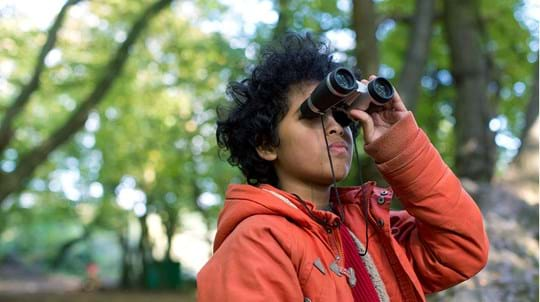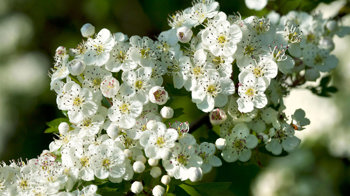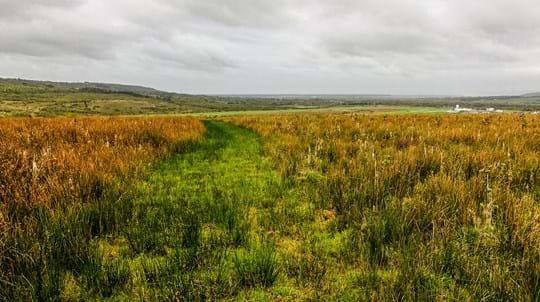
Coed Ffos Las
Carway

Woodland Trust wood group
- Coed Ffos Las
- Coed Ffos Las Access Track
49.93 ha (123.38 acres)
SN471060
Explorer NULL
OS Landranger NULL
Coed Ffos Las is a young woodland bursting into life, planted on the slopes of the Gwendraeth Valley as a memorial to lives lost in the First World War. As part of the Centenary Woods project, we planted 90,000 trees to create a new haven for wildlife.
The site is a combination of rolling landscape, panoramic views and wonderful woodland. As it develops, the woodland will include areas of coppiced trees for rural crafts and forest products and high canopy trees. A series of hedgerows around open grassland will provide ideal habitats for ground-nesting birds as well as hunting territories for owls and other birds of prey.
Visit Coed Ffos Las often to witness the changes of this developing wood and to reflect on what it represents. Be sure to visit Yr Arwr (Hero), the war horse sculpture.
Features
- Parking at site
- Public access
- Waymarked walk
- Grassland
- Marshland
- Broadleaved woodland
How to get to Coed Ffos Las
Coed Ffos Las lies directly south of the village of Carway and north of Llanelli, within the lower Gwendraeth valley. Comprising a single block of land covering 50 hectares (123.5 acres), it is immediately adjacent to the Ffos Las racecourse.
The main entrance is located from the village of Carway off the main road.
Access to the site is between two properties opposite the Bethel chapel and the village hall at the centre of the village.
Coed Ffos Las is between Kidwelly and Llanelli. Follow the brown tourist signs to the Ffos Las racecourse from Llanelli or the M4 at Carmarthen. The entrance to the site is from within the village of Carway, opposite the village hall in the centre of the village.
The closest train station is in Llanelli, around 11km (7 miles) away. Visit National Rail for more information.
The nearest bus stop is just after Siloh Baptist Church in Carway. Take the 197 bus which runs from Llanelli to Carmarthen. The buses are infrequent and depart every two hours. Visit Traveline Cymru for more information.
Facilities and access
There are three public access points. Paths across the site include a section of all-ability footpaths around the First World War interpretive areas of the site. Longer-distance paths lead across the site with viewpoints to the lower Gwendraeth valley and Carmarthen bay.
Permissive footpaths run across the entirety of the site and include compacted gravel surfaces suited to wheelchair users, with shallow gradients taking the visitor to the sculpture at the centre of the new woodland. These paths are accessed from the main car parking area and mobility kissing gate which is RADAR-key friendly. Further on and across the site is a series of grassed paths which extend for 3km and include footbridges and uneven surfaces.
There is a small car park at the entrance to the wood.
There are no facilities on site, but it is only a short walk to the village of Carway from the site entrance.
Wildlife and habitats
Animals
Coed Ffos Las is buzzing with life. Grassland areas are home to wildflowers that attract butterflies and moths, including meadow brown and ringlet. The open habitats also provide nesting sites for ground-nesting birds including skylarks.
As the site develops, it will make new habitats for wildlife. We’re hoping that the large area of new woodland will encourage dormice, which live nearby but have not been recorded on the site, as well as several species of bat known to live in the area.
Trees, plants and fungi
Open to the elements, especially the salty sea air, the main tree species selected for this new wood were oak and alder, but we’ve also planted birch, willow, hawthorn, holly, sweet chestnut, sycamore and lodge pole pine.
According to historical maps, much of the area used to be wooded, with a network of hedges and ancient woodland mixed with pasture. This new woodland will help to heal the scars of the landscape and, where possible and over time, recreate it.
Open ground habitat consists of a soft rush pasture and marsh grassland, as much of the land is damp and poorly drained. The occasional grey willow or clumps of common gorse surround the edges of the site.
Habitats
The mix of new woodland, marshland, soft rush pasture and newly planted and veteran hedges provides the ideal habitats for a variety of species.
Parts of the site have been intentionally left unplanted to aid a gradual transition of the current bird species to woodland-favouring species as the site develops.
History of Coed Ffos Las
The site once formed part of Dyffryn Maes Gwilym Farmholding and is still sometimes known locally as Maes Gwilym. The farm was demolished in the 1980s as part of open cast mining activity and some of the land was used for storage of ‘over-burden’ and machinery from the mine next door where the Ffos Las racecourse is located today.
The English translation of Ffos Las is ‘blue ditch’; while ‘coed’ translates as wood/trees.
Coed Ffos Las is one of our Centenary Woods.

Your support matters
We were able to plant trees here thanks to your response to an important appeal. Discover how you helped us create another incredible place for people and wildlife, and what the future holds for this new wood.
See what we've achievedThings to do at Coed Ffos Las

Visiting woods
Events
Discover events at our woods and the festivals and fairs you can find us at soon.

Visiting woods
Walking dogs in our woods
Dogs are welcome for walkies in our woods. Take a look at our tips and guidelines for ensuring we keep our woods safe and special for dogs and wildlife.

Visiting woods
Things to do in the woods
Go on an adventure. Get closer to nature. Uncover history. Discover ways to explore the UK's woods whatever the season.

A lasting legacy
This wood is just one of many to have been protected by gifts in wills, securing it for generations to come. Your legacy gift could also make a real difference to woods, trees and wildlife.
Learn what your gift could mean




























